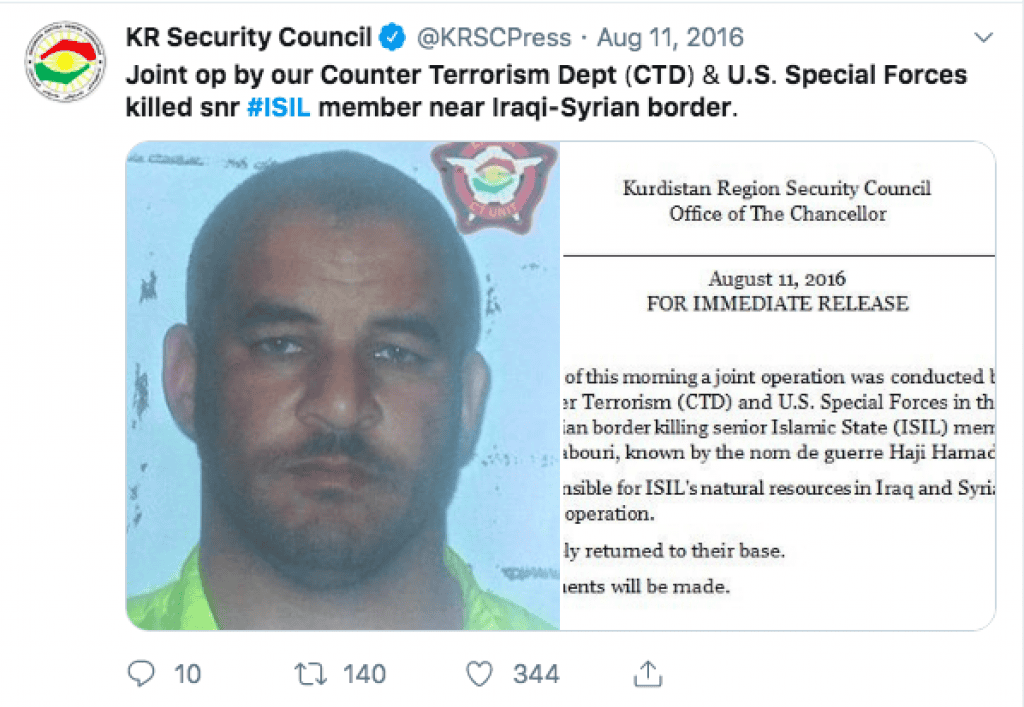
On Aug. 21, the US State Department Rewards for Justice Program announced rewards of up to $5 million each for three wanted Islamic State (ISIS) leaders: Sami Jasim Muhammad al-Jaburi, Amir Muhammad Sa’id Abdal-Rahman al-Mawla, and Mu‘taz Numan ‘Abd Nayif Najm al-Jaburi. Respectively, the three are: a money man, a senior ideologue, and an explosives expert.
Interestingly, all three of the so-called caliphate’s men began their jihadist careers with al Qaeda in Iraq (AQI), the forerunner to the current Islamic State organization. The State Department says al-Mawla “was a religious scholar in ISIS’s predecessor organization,” AQI, while both al-Jaburis are “legacy” AQI members.
It is not clear if the State Department means AQI as it existed before the establishment of the Islamic State of Iraq (ISI) in 2006, or the ISI. Either way, the brief biographical details provided for all three men demonstrate that the current Islamic State retains a cadre of veterans who have been with the enterprise for years, and in some cases possibly a decade or more.
Sami Jasim Muhammad al-Jaburi (a.k.a. Hajji Hamid and Haji Hamad) was reportedly killed in 2016, but the newly-released reward announcement indicates the US government thinks he survived.
On Aug. 11, 2016, the Kurdistan Region Security Council (KRSC) reported that Sami al-Jaburi and “an aide were killed” in a joint operation involving US Special Forces. The KRSC described al-Jaburi as “responsible” for the Islamic State’s “natural resources in Iraq and Syria.” That part was true, based on other sources, but al-Jaburi apparently wasn’t killed in the raid.

Sami al-Jaburi has long been a key Islamic State money man.
The Treasury Department added him to the US government’s list of specially designated global terrorists in 2015, reporting that as of that same year he “supervised” the Islamic State’s “oil and gas, antiquities, and mineral resources operations.”
He had worked with another Islamic State “oil and gas official,” Fathi ben Awn ben Jildi Murad al-Tunisi (a.k.a. Abu Sayyaf), to “establish a new funding stream for [ISIS] from increased production at oil fields held by the organization,” Treasury said. That effort took place in Apr. 2015.
Abu Sayyaf was killed in a US raid in eastern Syria the following month. The raid provided US intelligence officials with a treasure trove of information recovered from Abu Sayyaf’s compound. The Islamic State man’s wife, Umm Sayyaf, was also captured during the operation.
Brett McGurk, who was then the Special Presidential Envoy to the Global Coalition To Counter ISIS, explained months later that the Americans “collected more information off that site than we have in any Special Forces operation in history.” The intelligence led “to a number of operations to really just completely uproot [ISIS’s] economic financial networks in Deir al-Zor in eastern Syria,” McGurk said.
But assuming Sami al-Jaburi is indeed alive, at least some of Abu Sayyaf’s close comrades survived the roll up of his network after the raid in eastern Syria.
Al-Jaburi’s career has followed the Islamic State’s rise to power as a nascent state in 2014 and 2015, as well as its subsequent reversion to guerrilla warfare. Treasury described al-Jaburi as ISIS’s “shari’a council chief and second in command in southern Mosul, Iraq” as of Aug. 2014 — that is, just weeks after the organization declared Abu Bakr al-Baghdadi to be “Caliph Ibrahim.”
According to State, whle al-Jaburi was serving as the Islamic State’s “deputy” in southern Mosul, he also “reportedly served as the equivalent of ISIS’s finance minister, supervising the group’s revenue-generating operations from illicit sales of oil, gas, antiquities, and minerals.” He is presumably still serving in a similar capacity today.
In 2017, the US Treasury Department identified another key Islamic State finance official who was formerly in Mosul as Salim Mustafa Muhammad al-Mansur. After the fall of Mosul, which was once one of the Islamic State’s two most important cities, al-Mansur fled to Turkey. Al-Mansur’s current status is not publicly known. But like al-Jaburi and the two other Islamic State officials added to the State Department’s rewards program this week, al-Mansur’s career began with AQI/ISI.
The photo accompanying al-Jaburi’s reward offer indicates that he was once imprisoned. As has been widely documented, the detention facilities in Iraq proved to be a breeding ground for the Islamic State, as the jihadists used their confinement to recruit new men to their cause, while others’ views hardened. Many of the Islamic State’s top leaders were once imprisoned, only to be freed.

The State Department offers an intriguing assessment in its description of Amir Muhammad Sa’id Abdal-Rahman al-Mawla (a.k.a. Hajji ‘Abdallah), saying that he is “a potential successor” to Abu Bakr al-Baghdadi as the head of ISIS. Foggy Bottom doesn’t explain how it arrived at this analysis, and the Islamic State doesn’t publish succession charts. But it may have something to do with al-Mawla’s extensive ideological work inside the organization.
The US government describes al-Mawla as a “senior” ISIS leader who served as a “religious scholar” for AQI. He “steadily rose through the ranks to assume a senior leadership role for ISIS.” Then, as one of Baghdadi’s “most senior ideologues,” al-Mawla “helped drive and justify the abduction, slaughter, and trafficking of the Yazidi religious minority in northwest Iraq.”
The Islamic State’s rampage through Sinjar in northern Iraq forced hundreds of thousands of Yazidis to flee. The jihadists carried out a genocide, enslaving thousands of Yazidi women and children while massacring thousands of men who refused to convert to the Islamic State’s version of Islam. Yazidi women and girls were forced into sex slavery.
And according to the State Department, al-Mawla provided ideological arguments to justify this barbarity. That isn’t all he does for the Islamic State. The US says al-Mawla “is believed to oversee some of the group’s global terrorist operations” — though the Rewards for Justice program didn’t specify what role he plays, exactly.
Mu‘taz Numan ‘Abd Nayif Najm al-Jaburi (a.k.a. Hajji Taysir) is the third and final wanted Islamic State figure. Unlike the other two, the US apparently has no photo of the man, despite the fact that he is considered “one of the most important leaders in ISIS.” As of mid-2017, according to the State Department, al-Jaburi was the “deputy amir of manufacturing in Syria.” And in that role, he oversaw the “Research Department for ISIS’s chemical and biological weapons efforts in Syria.”
The US government has identified other ISIS figures responsible for developing chemical and biological weapons in the past. [See, for example, FDD’s Long War Journal reports: US designates ISIS chemical weapons expert from France as terrorist, US designates 2 Islamic State leaders tied to chemical weapons, US military hits another Islamic State chemical weapons facility in Iraq and Coalition kills Islamic State ‘chemical weapons engineer’.]
Thus far, the Islamic State’s chemical arsenal has been fairly rudimentary, relying on chlorine and mustard agent. The Islamic State of Iraq (ISI), the predecessor organization to the current Islamic State, used chlorine gas in a series of suicide bomb attacks in 2007. However, it is always possible that the group has been exploring more sinister and sophisticated weaponry.
Despite losing its territorial caliphate, it is well-known that the Islamic State has thousands of members across Iraq and Syria, perhaps many thousands. Western analysts do not really known how many ISIS men remain on the battlefield, or hidden in sleeper cells, waiting to strike. Thousands of others remain loyal to the organization elsewhere around the globe.
But the State Department’s newly-released summaries for these three leaders provide additional evidence that the organization retains “legacy” cadres.







